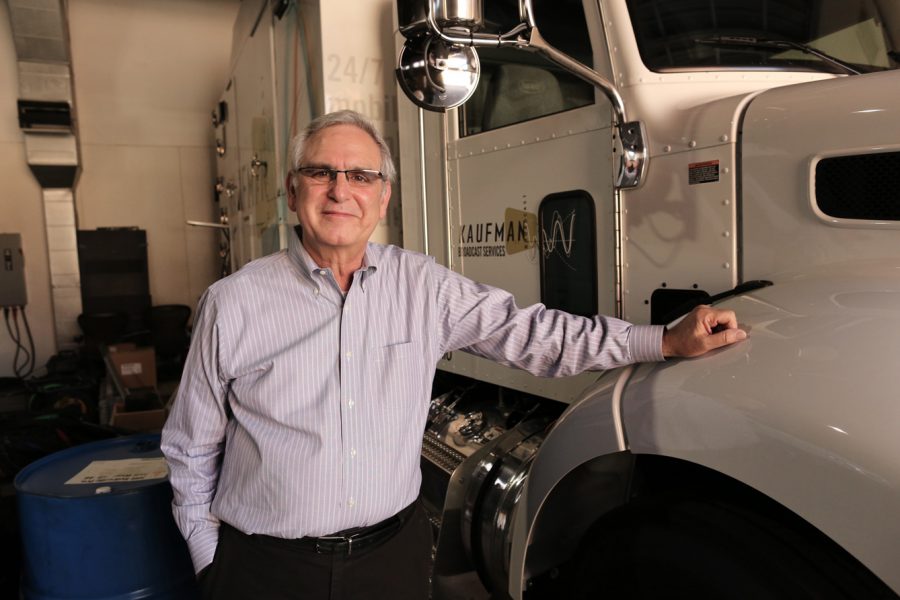TV/radio expert keeps Cardinals—and the High Holidays—on the air
Published September 4, 2020
Bill Kaufman is spending much of his time these days managing broadcast services for one venue where people typically sing “Take Me Out to the Ball Game,” as well as one where “Avinu Malkeinu” is a familiar song.
But now, Busch Stadium and the sanctuary at Kol Rinah’s new synagogue are mostly empty.
So Kaufman, a longtime broadcaster, is trying to create a familiar experience for people watching events that used to have crowds.
ADVERTISEMENT
When Kaufman isn’t ensuring that Cardinals radio announcers, who aren’t traveling with the team this year, can call road games from Busch Stadium, he is helping the Conservative congregation prepare to broadcast its High Holiday services.
Because of the ongoing threat of the coronavirus, people will not be gathering this month at the synagogue for Rosh Hashanah or Yom Kippur.
So for those watching at home, “everything is going to sound recognizable, it will just look a little different,” he said.
Kaufman, a longtime member of Brith Sholom Kneseth Israel, which merged with Shaare Zedek in 2013 to become Kol Rinah, has been participating in weekday services.
ADVERTISEMENT
“I have found it interesting going to minyan from home, and in many ways, you kind of adapt to the environment and get used to praying with others, and, before and after services, having conversations with them the same way you and I would talk if we were on a Zoom meeting,” he said.
Kaufman, 63, became interested in broadcasting as a child because his father’s law office was downtown in the Arcade Building, which also housed the KATZ radio station.
“I used to go down to the radio station on Saturdays and just sit around and watch what the engineers and DJs were doing, and that kind of started it,” he said. “It just seemed like something I could do. … Technology was something I always had fun with. We had a reel-to-reel recorder at our house, and I would hold the microphone up to the radio and either record myself talking or record shows off the radio, and I think it just felt good.”
Kaufman started working in broadcasting as a student at Clayton High School, which held the license for KHRU-FM (88.1), now the independent music station KDHX. He also interned at KETC, the public television station, and eventually got a job reporting and weekend anchoring at KPLR-TV (Channel 11).
“I decided that I was probably a better behind-the-scenes person than out in front, so I switched to the engineering side,” said Kaufman, who still lives in Clayton.
He built his business, Kaufman Broadcast, around helping companies with videoconferencing at hotels and offices. In 1985, he managed a broadcast transmission of the World Series between the Cardinals and Kansas City Royals, and in 1995, started overseeing the audio/visual and scoreboard equipment at the old Busch Stadium.
He continued to deepen his relationship with the team and started regularly managing the broadcasts when it moved into the current stadium in 2006. He also started helping with broadcasts for Blues and Rams games and for events televised on ESPN.
In March, when public officials blew the whistle on normal life in the United States, “We got hit like everybody else when the NCAA got shut down. All of our business came to a grinding halt.”
As sports have restarted, his company has provided satellite trucks for boxing matches in Las Vegas and for Major League Soccer and National Basketball Association games in Orlando.
Kaufman said there is precedent for sportscasters calling events remotely; announcers have long done it from the United States for the Olympics.
“I think the biggest thing that is lost is the announcers’ ability to interact with the coaches, the managers,” he said. “What a lot of people don’t think about is that when television and radio broadcasters come in for a game, they are going down and talking to players and managers and getting information and getting a sense of what is going on in the background that they can talk about during a broadcast. But when they show up now, there is nobody there.”
Kaufman has experience managing the audio in holier settings, too. Rabbi Noah Arnow of Kol Rinah recalls that they were once arranging sound for the High Holidays at their former building in University City and had placed a microphone underneath a ceiling speaker, which was causing feedback.
“Bill said, ‘If we can just cover up the speaker with something, that won’t be a problem,’ ” Arnow said.
The expert found an old pizza box in the building, cut a square from it and pasted it atop the speaker. The feedback disappeared. The congregation has since moved out of the building, but the cardboard remains, Arnow said.
“Bill is such a gift to Kol Rinah because not only does he have the skills and expertise that are incredibly useful, but he is so willing to share and help and does so in such a quiet, behind-the-scenes way,” Arnow said.
For the High Holiday services this year, the congregation had hoped to be fully moved into its new building in Clayton, with all of the audio equipment installed. But the move will not be complete by then, so Kaufman is rigging a backup audio system.
The congregation will broadcast parts of the service from the synagogue and some readings from members at their homes. Kaufman recently was working to ensure that the services can be streamed without a time limit, so that people whose observance includes not turning technology on or off over the holiday can just leave it on.
“Some of it is experimentation,” he said. “Every congregation is dealing with this around the world. We are all learning new tools and how to use them.”
Arnow put Kaufman’s contribution in sharper focus.
“Without him, we would be in big trouble right now,” he said. “We would be scrambling.”
















